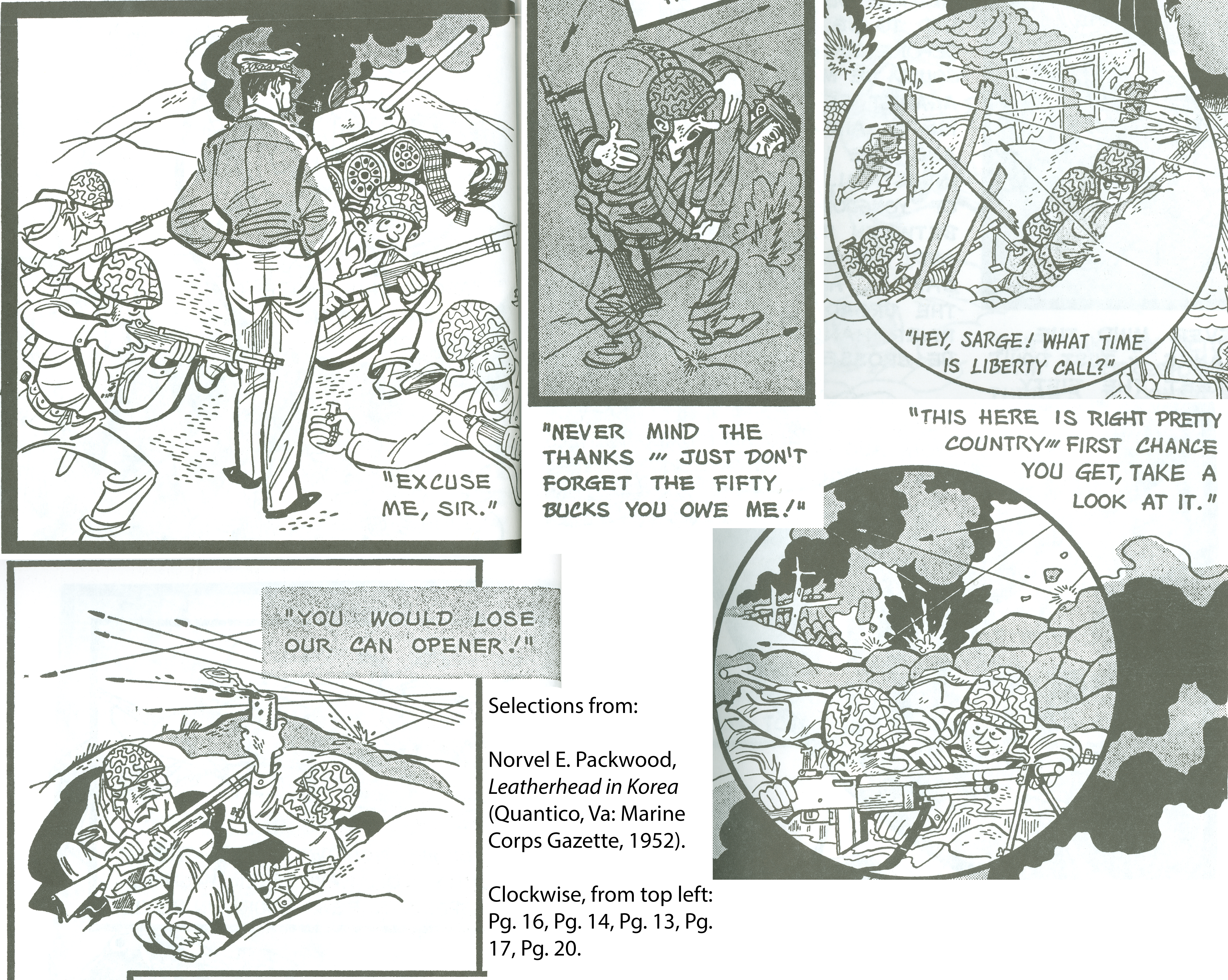The publication Leatherhead in Korea was a collection of comedic cartoons published by Norvel E. Packwood, an artist for the Marine Corps Gazette. The comics were originally published in the Gazette, and were compiled into this publication in 1952. The comics in Leatherhead in Korea were short - generally one panel - and drew upon Packwood’s experiences in the field. His pieces differed from many of the other comics I examine, in that they are less propagandistic, and only sought to make light of typical situations the soldiers found themselves in.
One common theme across the collection of comics in Leatherhead in Korea was the ability of soldiers to act oblivious to enemy fire, and to make witty remarks or carry on with their casual conversations as though they were at no risk. Though done in jest, these depictions do carry with them an understanding that the men are fearless and could not be rattled by anything. This presented a different sort of fearlessness than the comics in the Aggressiveness and Adventurousness section, where men would directly counter danger with aggression. Nonetheless, Packwood offered a counter to men cowering in foxholes or running away from threats. This humorous form of stoicism, though perhaps less valorous than its aggressive counterparts, did reinforce the idea that these soldiers did not feel emotion, or that they were able to hide their emotions and act as though nothing was wrong, even under the most dire and deadly situations.
Leatherhead in Korea delved into a long and very serious discussion of the Chosin Breakout, and attacked the usage of the word “retreat: to describe the actions, arguing that it paints them in cowardly terms. The issue is introduced in a two-page illustration that used humor to show the dire situation American troops were facing. Two men were up against an overwhelming onslaught of enemy troops and say, “To hell with tradition. Let’s get out’a here.”[^] The rather than taking on the overwhelming force, as many examples in the (Aggression and Adventurousness section)/adventurousness.html or “retreating,” the men decide to get out of the situation. Even though they knowingly go against tradition and relocate, they are not shown as being frightened, but rather as calm and cool.
The following three pages, nearly all expository text, discussed the line between retreat and relocation in a much more serious manner, dissecting the events and press coverage of the Chosin Breakout. Packwood angrily lamented that some members of the press ”…erroneously used the words retreat and trapped in their descriptions of the Chosin Breakout.”[^] Packwood was highly offended and insulted by this language and openly maligned the journalists who initially covered the event. He then quoted a statement from General Lemuel C. Shepherd, Jr., who said, ”…despite the frequent accounts in the press, the men of the First Marine Division did not retreat. They obeyed orders…to conduct an orderly move from exposed positions to a more secure area near Hamhung.”[^] Packwood went on to disavow the use of the word “trapped,” saying that the First Marine Division was prepared for an attack from guerrilla forces and thus, ”…when the crisis arose it was readily met.”[^]
Packwood then described the troop movements in the most complementary way, stating that they were ’…in a new and different war, engaged with a numerically superior and fresh enemy…” and had to relocate and concentrate its forces.[^] He even made the movements sound heroic, saying the men were forced to move ”…southward over 75 miles of the most tortuous mountain roads conceivable.”[^] He added that the First Marine Division launched ”…a series of deadly attacks which resulted in the complete route of all six of the Chinese divisions opposing it.”[^] He then returned to the offensiveness of the term “retreat,” saying of the situation, ”…by no stretch of the imagination can this be described as retreat, since a retreat presupposes defeat – and the only defeat involved in this battle was the one suffered by the Chinese…”[^]
Although there is obviously and deservedly a concern over the factuality of reports on the fighting, this sort of response against the use of a few words, from commanders as well as journalists and comic writers, shows a serious concern over their self-defined honor and heroism. This shows that these Marines were forever conscious and defensive about the descriptions of the heroics of the Marines, and were determined to prove that they were not scared or eager to retreat.
Related Sections
- Inexpressiveness and Independence
- Inexpressiveness and Independence - Flight into Fury
- Inexpressiveness and Independence - Look After My Billy!
- Inexpressiveness and Independence - Marines No. 4
- Inexpressiveness and Independence - Victory at Gavutu
- Adventurousness & Aggressiveness
- Antifemininity - Leatherhead in Korea
- Be a Big Wheel - Sexual Appeal and Adoration - Leatherhead in Korea
Primary Sources




